Sapin-Sapin is as tasty as it is pretty! Soft, chewy, and topped with golden latik, this Filipino steamed glutinous rice cake is a delicious midday snack or after-dinner dessert.
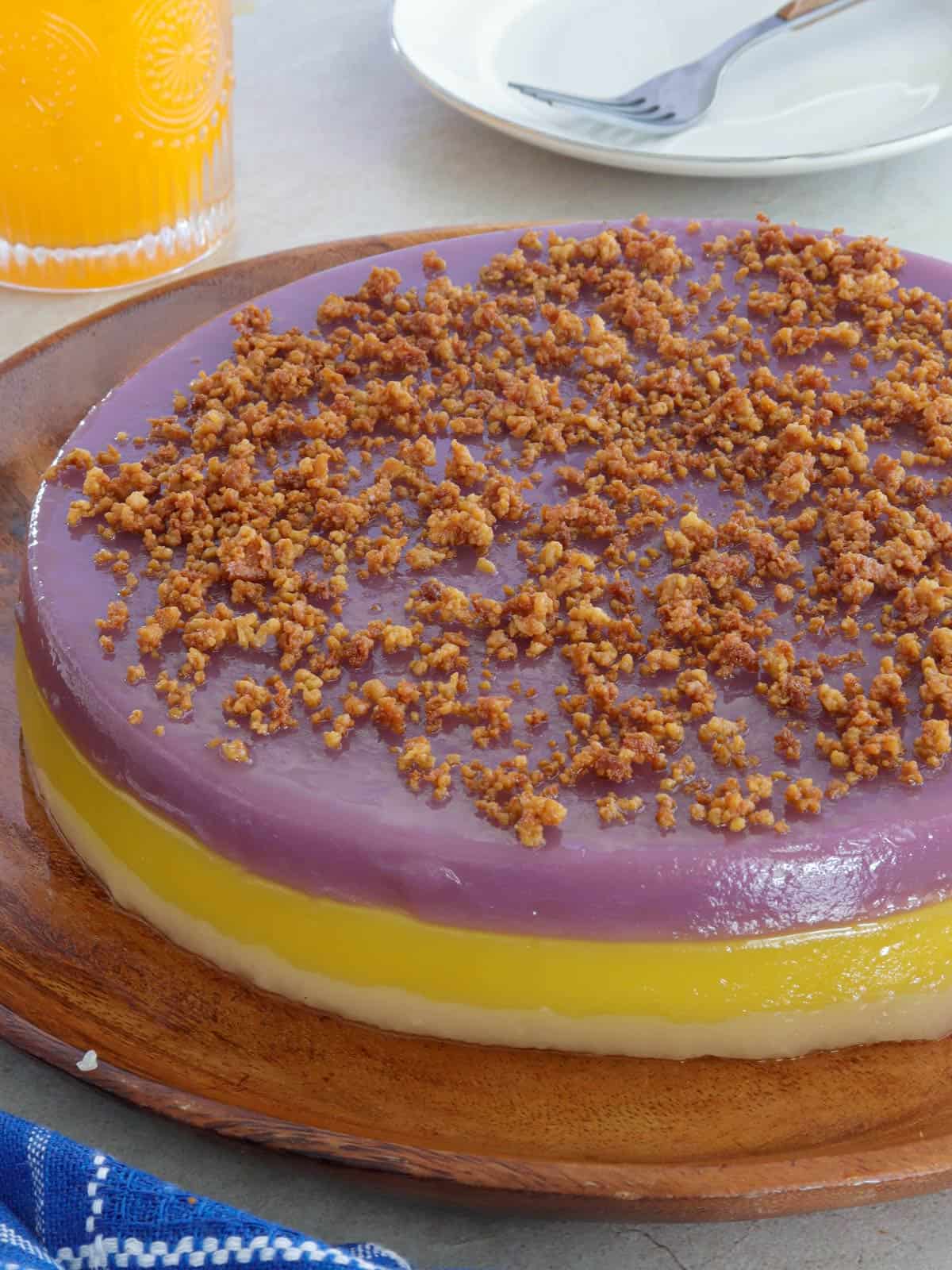
I've wanted to make sapin-sapin for the longest, but I was intimidated by what I thought to be a very complicated process. So when I went home to the Philippines a few years ago, I asked our suking magkakanin to teach me, along with other kalamay recipes like Palitaw, Kapit, Royal Bibingka, and Kalamay Hati.
As it turned out, I didn't need a 7,185-mile trip to learn how to make this Filipino steamed cake. The whole process is easy; it's almost child's play!
Ingredient list
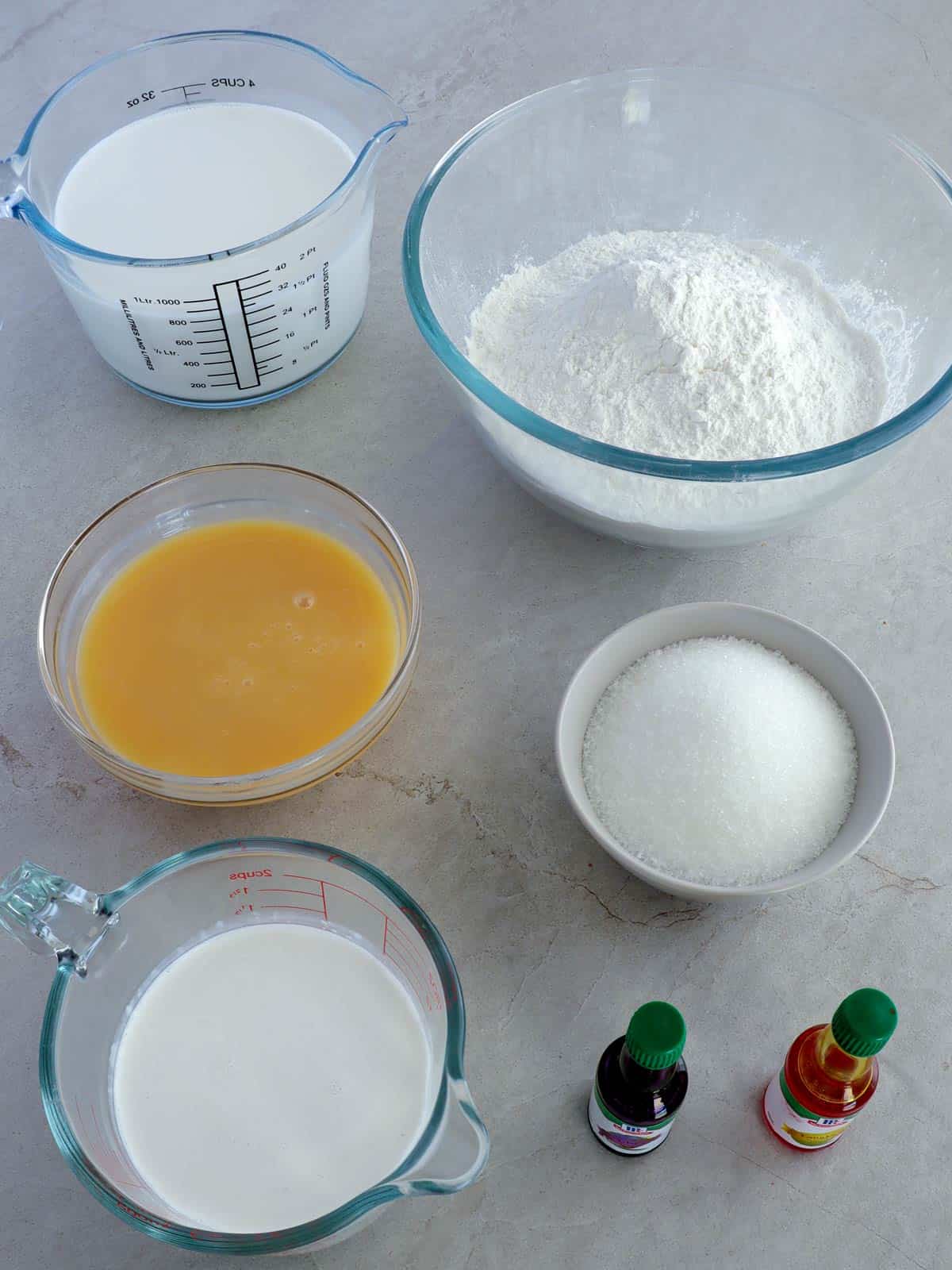
- Coconut cream - also called kakang gata, is used to make the latik topping. As it's the first extraction from grated coconut and is thicker, richer, and creamier, it will reduce quicker.
- Glutinous rice flour- Locally known as malagkit. Also called sticky or sweet rice flour, it gives the dish its signature chewy texture. The steamed kalamay is traditionally made by soaking rice grains in water overnight to soften them and then grinding them into a thick batter or galapong mixture. Using rice flour makes the process so much easier.
- Coconut milk- adds a rich, creamy taste to the batter. You can use freshly pressed or canned for convenience.
- Condensed milk- a dense liquid made from cooking down milk to remove its water content. It adds sweetness and creaminess.
- Sugar- add more or less to adjust the level of sweetness to your liking
- Flavor extracts- the recipe uses ube and langka extracts to add color and flavor.
Prepare the pan
- The rice batter is about 6 cups which fits perfectly in an 8 x 2 round baking pan. You can also use an 8 x 8 square pan with an 8-cup capacity. Or a springform pan to make releasing the sticky rice cake easier.
- Liberally grease the inner sides and bottom of the baking pan to be able to remove the sticky rice cake easily after steaming. You can also use wilted banana leaves to line the pan or parchment paper.
Sapin-sapin cooking steps
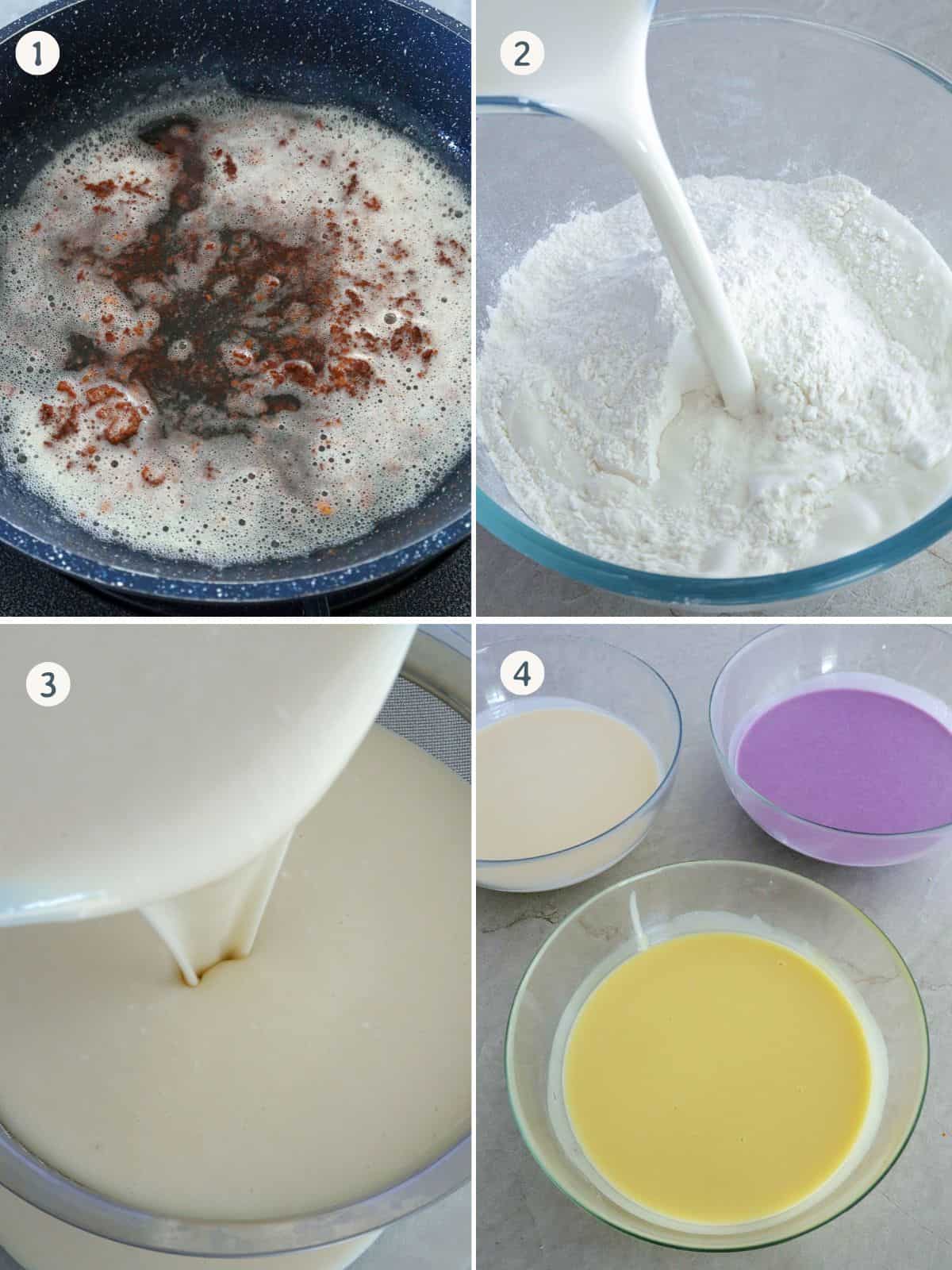
Sapin-Sapin, which means layers, is one of the easiest Filipino desserts you can make. It's so much fun watching everything come together into one colorful sweet treat! You'll be amazed at how something so gorgeous and delicious can be put together with minimal effort.
- Make the latik- check out my tutorial on how to make latik for detailed steps and tips. Drain the coconut curds well and store them separately from the coconut oil until ready to use. While you can use toasted coconut shreds instead, I urge you to make the extra effort. The latik taste so much better, and the rendered oil can be brushed on the sapin-sapin to add aroma and flavor.
- Make the batter- combine the glutinous rice flour, coconut milk, condensed milk, and sugar in a large bowl. Stir together until the sugar is dissolved and the mixture is smooth and well blended.
- Strain the batter- run into a fine-mesh sieve to remove any lumps and divide evenly into three bowls.
- Add the extracts- stir the ube in one bowl and the langka in another bowl until well dispersed, leaving the third portion plain and white. I use about 3 to 4 drops of each extract to achieve the color I like. Note that the colors of the tinted batters will be light but will deepen when steamed and cooked.
- Steam the batter- pour and steam each colored batter individually on top of each other until a toothpick inserted in the center comes out clean.
- Cool- remove the cake from the steamer and allow it to cool completely to make it easier to release from the pan. Run a knife around the sides of the pan to loosen the rice cake. Do not cover the kalamay until sufficiently cooled, as the steam will cause water puddles on the cake.
- Serve- carefully invert the pan on a wide platter and tap a few times to release the sapin-sapin onto the platter (the purple layer will now be the top layer). Liberally brush with coconut oil, sprinkle latik on top, and cut into serving portions.
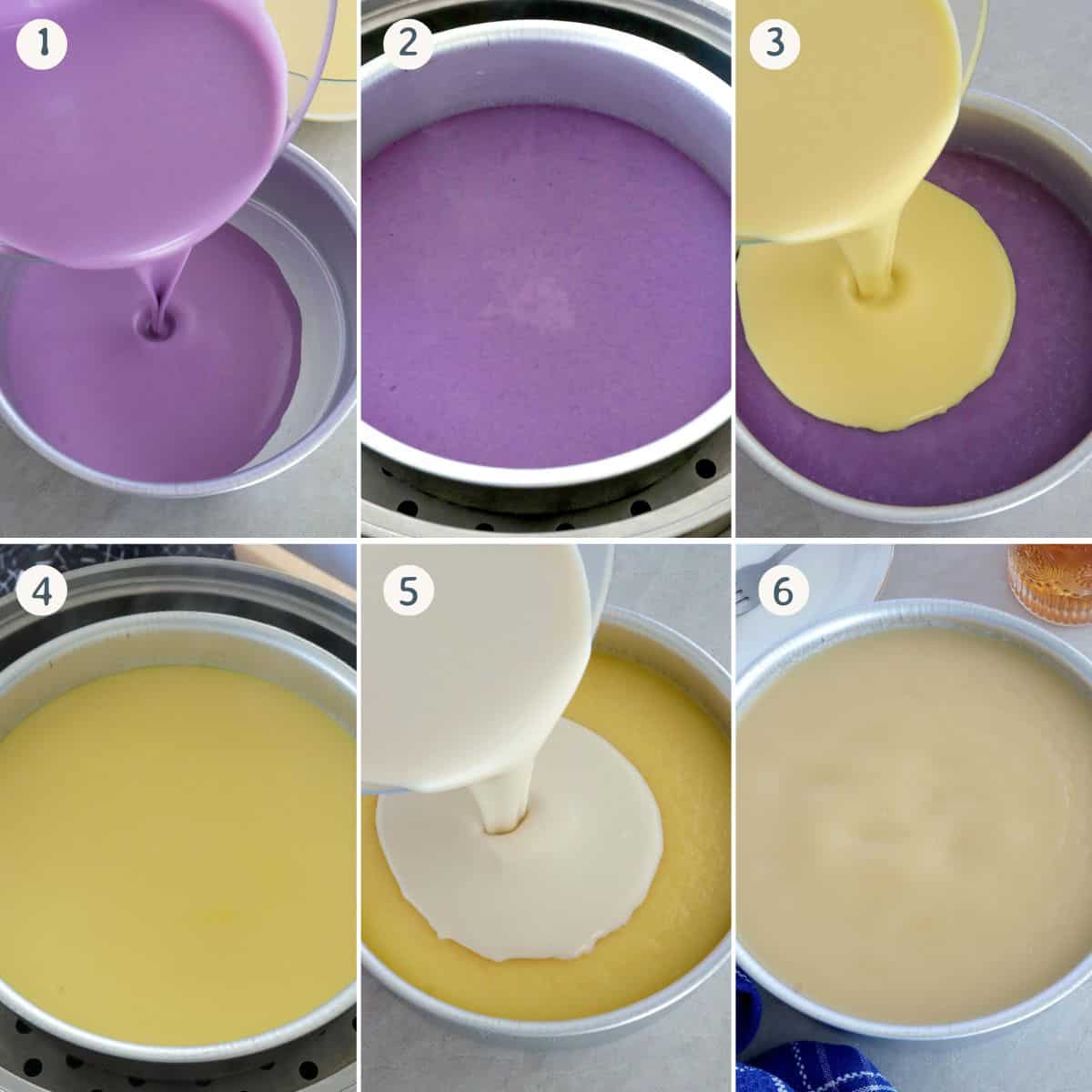
Cooking tip
To make the sapin-sapin extra special and more traditional, stir in about ½ cup of mashed cooked ube to the purple-colored mixture, ¼ cup of finely chopped jackfruit (langka) to the yellow-colored mixture, and ¼ cup chopped macapuno strips to the white mixture.
Frequently Asked Questions
What is the meaning of sapin-sapin?
Sapin-sapin literally means "sheets or layers" in the Filipino language. The name comes from the process of steaming the colored layers on top of each other.
What are the characteristics of sapin-sapin?
It's a multi-layered sticky rice cake with various flavors and coloring, such as ube and langka. This steamed kakanin is soft and chewy with a hint of coconut flavor from the use of glutinous rice flour and coconut milk. It's traditionally topped with latik or toasted desiccated coconut.
What is the history of sapin-sapin?
The word kakanin is derived from the word "kanin" and is the blanket term for Filipino delicacies made of rice. Sapin-sapin is a type of kakanin that originated in the Northern province of Abra and has spread in popularity throughout the country.
Does it need to be refrigerated?
Yes! As the kalamay is made of coconut milk, it can spoil quickly, especially in warmer weather. Allow it to cool completely before covering, as the escaping steam might cause water puddles on top of the cake. Refrigerate for up to 3 days. When ready to serve, warm up in the microwave for a few seconds to soften.
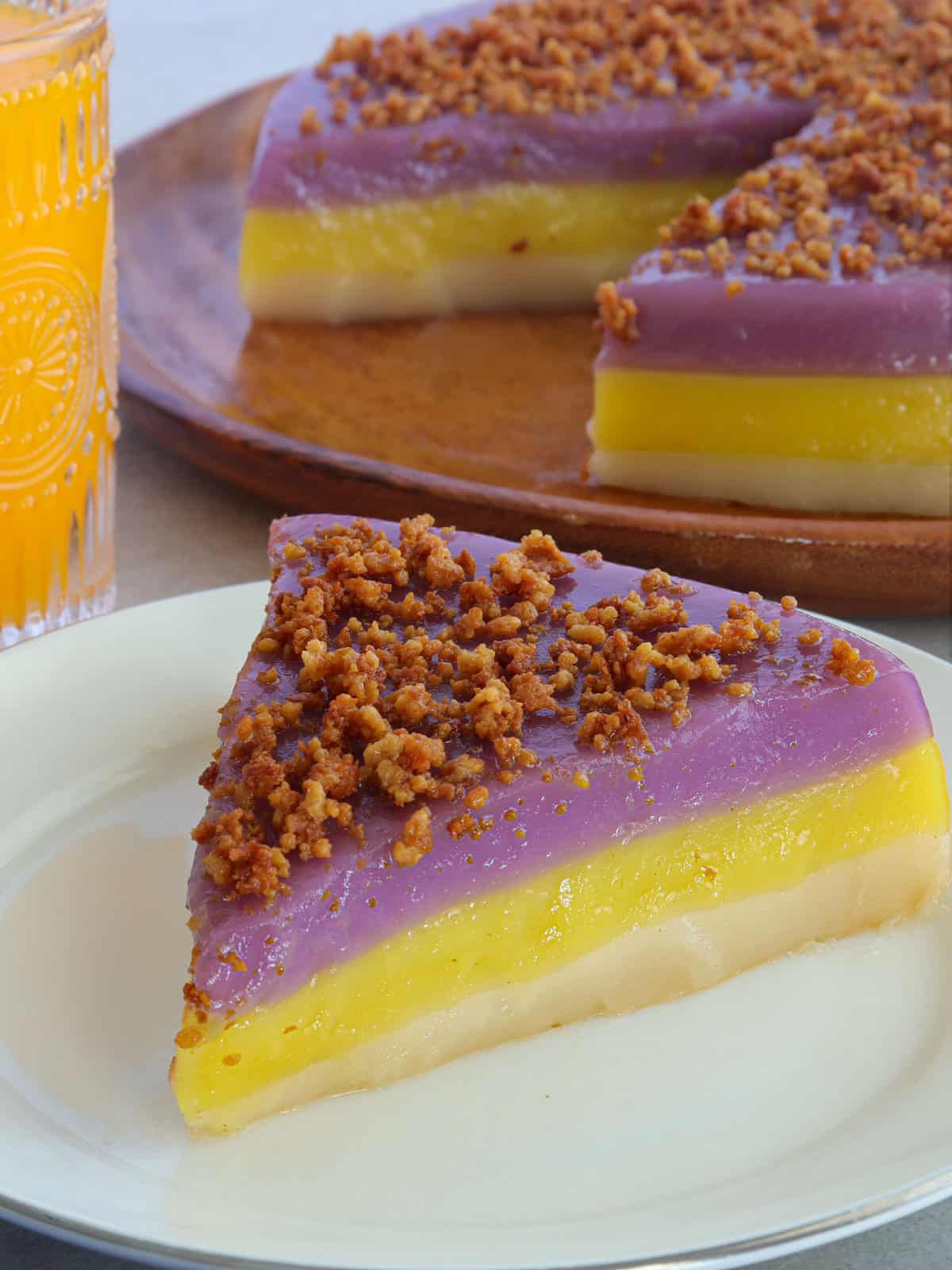
Serving suggestions
Sapin-sapin is a tasty and filling midday snack or after-meal dessert. Slice into wedges and enjoy it with coffee, tea, tsokolate, or cold sago at gulaman!
More kakanin recipes
Ingredients
For the Latik
- 1 cup coconut cream (kakang gata)
- 3 ½ cups glutinous rice flour
- 2 cans (13.5 ounces each) coconut milk
- 1 can (14 ounces) condensed milk
- 1 cup sugar
- 3 drops ube flavor extract
- 3 drops langka flavor extract
Equipment
Equipment
- Steamer
- 8x2 round pan
Instructions
- In a pan over medium heat, add coconut cream and bring to a boil. Cook, stirring occasionally until liquid starts to thicken.
- Lower heat and continue to cook. As oil starts to separate and solids begin to form, regularly stir and scrape sides and bottom of the pan to prevent from burning. Continue to cook and stir until curds turn golden brown.
- Drain latik from the oil and store in separate containers until ready to use.
- Generously brush inner sides and bottom of an 8-inch round baking pan with the oil.
- In a large bowl, combine glutinous rice flour, coconut milk, condensed milk, and sugar. Stir together until sugar is dissolved and mixture is smooth and well blended.
- Strain the batter using a fine-mesh sieve and divide evenly into three bowls.
- In one bowl, add ube extract and stir until color is well dispersed. In another bowl, add Langka extract and stir until color is well dispersed. The remaining portion will be white and plain.
- Pour ube-flavored batter into the prepared baking pan. Steam for about 10 minutes or until set and toothpick inserted comes out clean.
- Carefully pour langka-flavored batter over purple layer. Steam for about 10 minutes or until set and toothpick inserted comes out clean.
- Gently pour plain batter over yellow layer. Steam for about 10 minutes or until set and toothpick inserted comes out clean.
- Remove cake pan from steamer and allow to cool completely.
- Run a knife around the sides of the pan to loosen the rice cake. Place a wide, flat serving platter over cake pan and gently invert. Tap the pan a few times to release the sapin-sapin onto the platter (purple layer will now be the top layer).
- Liberally brush top and sides of sapin sapin with coconut oil. Sprinkle latik on top and cut the cake into serving portions.
Notes
- The rice batter is about 6 cups which fits perfectly in an 8 x 2 round baking pan. You can also use an 8 x 8 square pan with an 8-cup capacity.
- For easy removal of steamed cake, liberally grease the inner sides and bottom of the baking pan. Or use wilted banana leaves to line the pan or parchment paper.
- To make the sapin-sapin extra special, stir in about ½ cup of mashed cooked ube to the purple-colored mixture and ¼ cup finely chopped jackfruit (langka) to the yellow-colored mixture.
- Allow the kalamay to cool completely before covering, as the escaping steam might cause water puddles on top of the cake.
Video

Nutrition Information
“This website provides approximate nutrition information for convenience and as a courtesy only. Nutrition data is gathered primarily from the USDA Food Composition Database, whenever available, or otherwise other online calculators.”

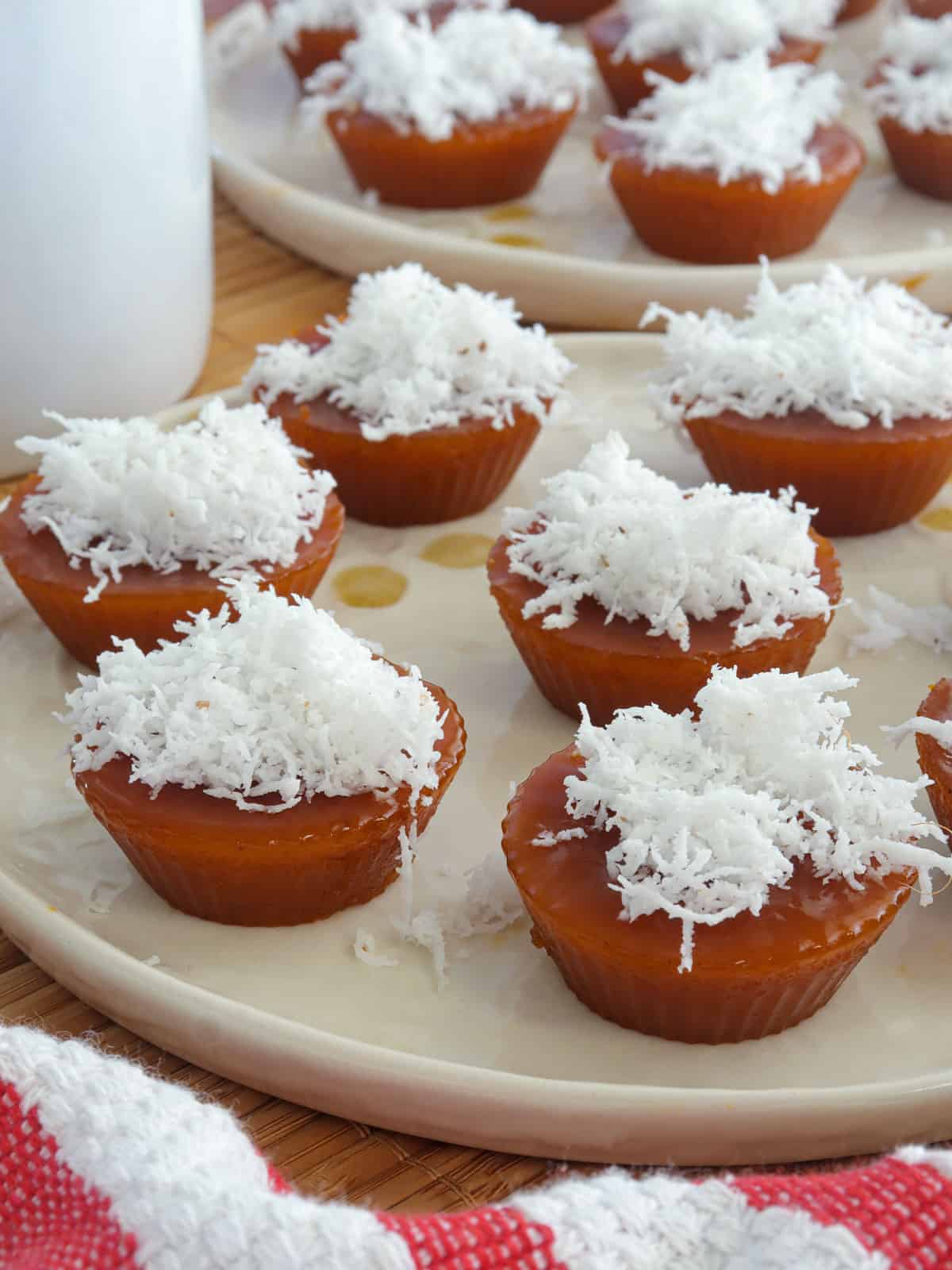
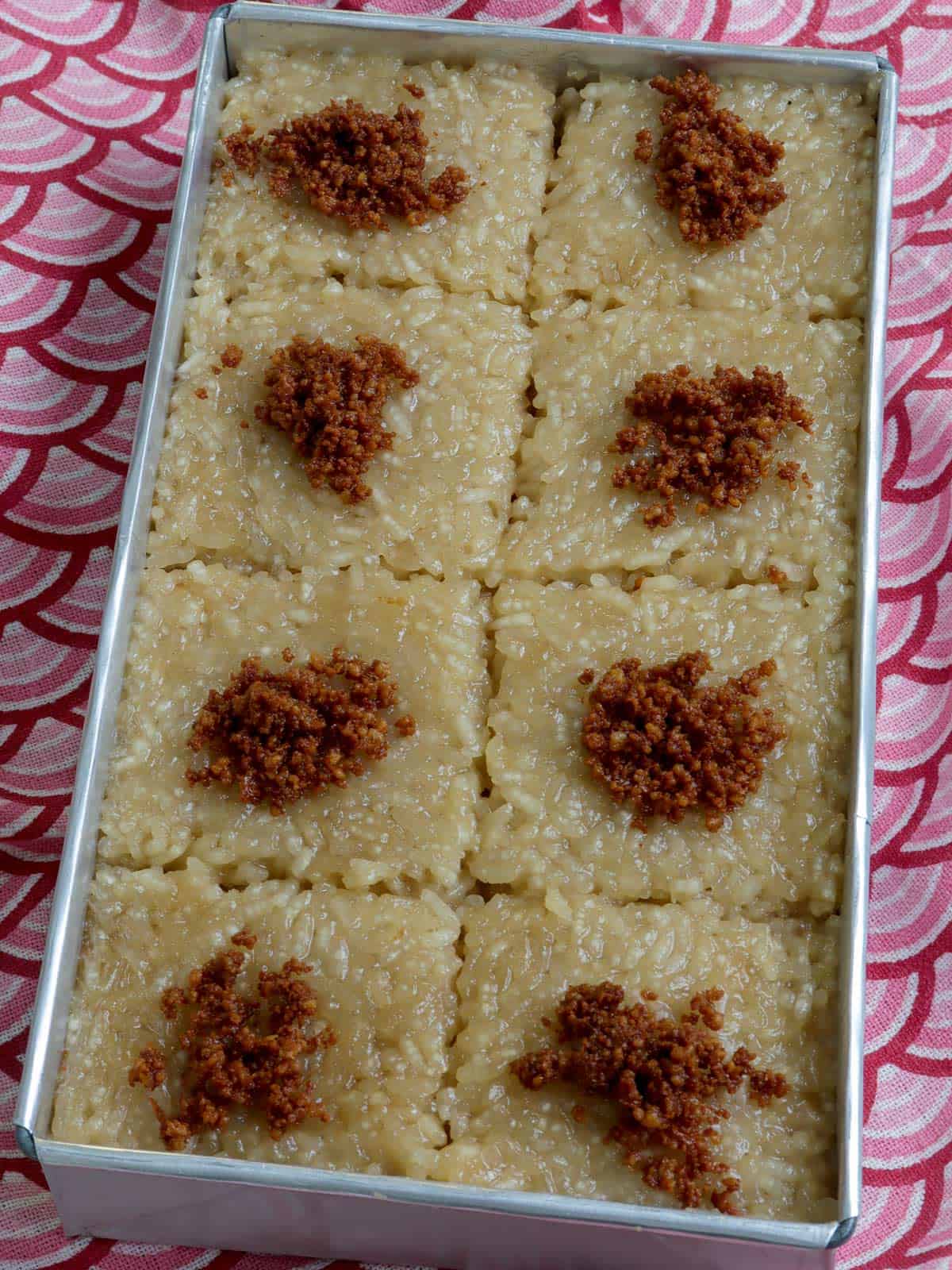

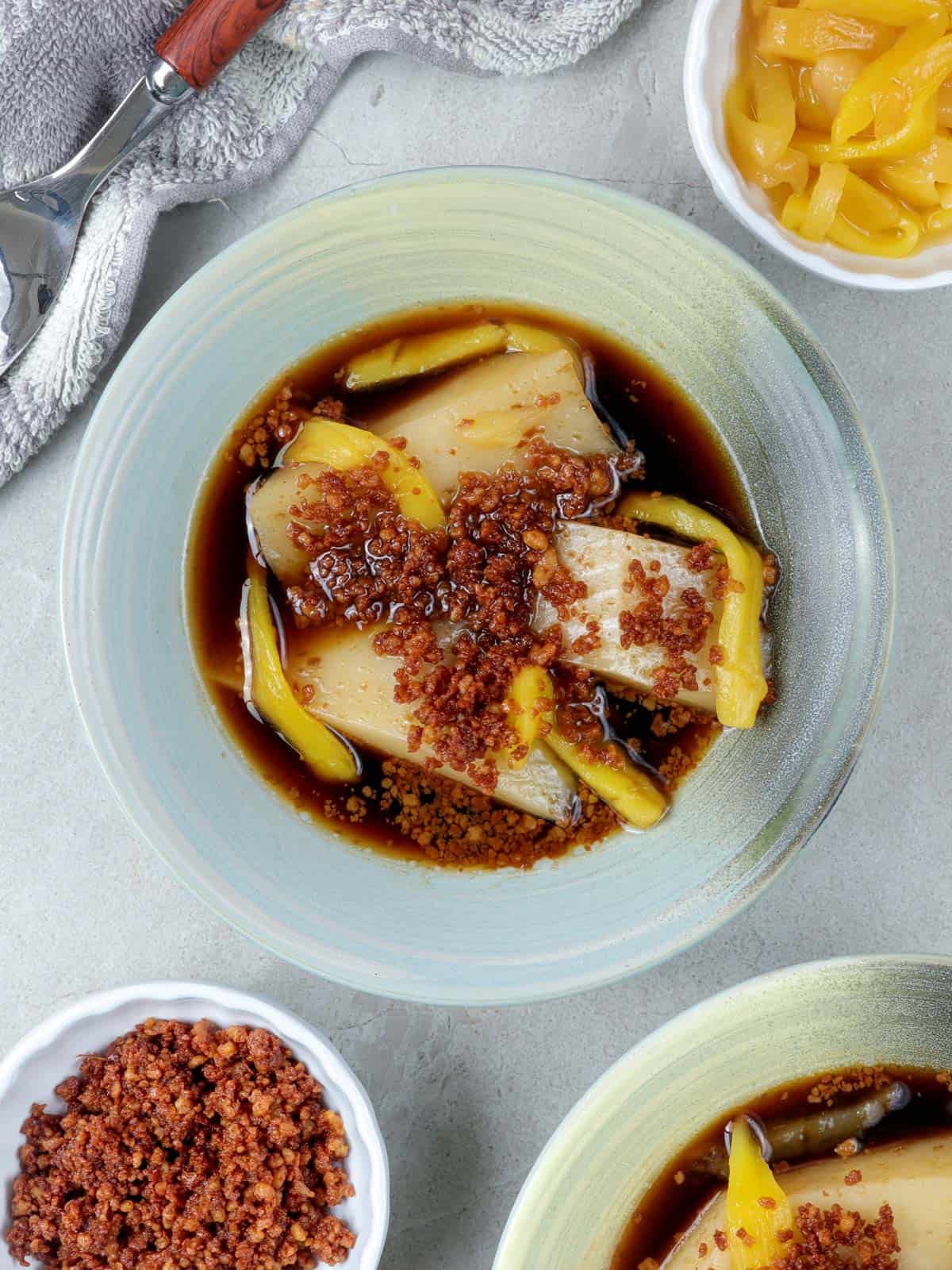

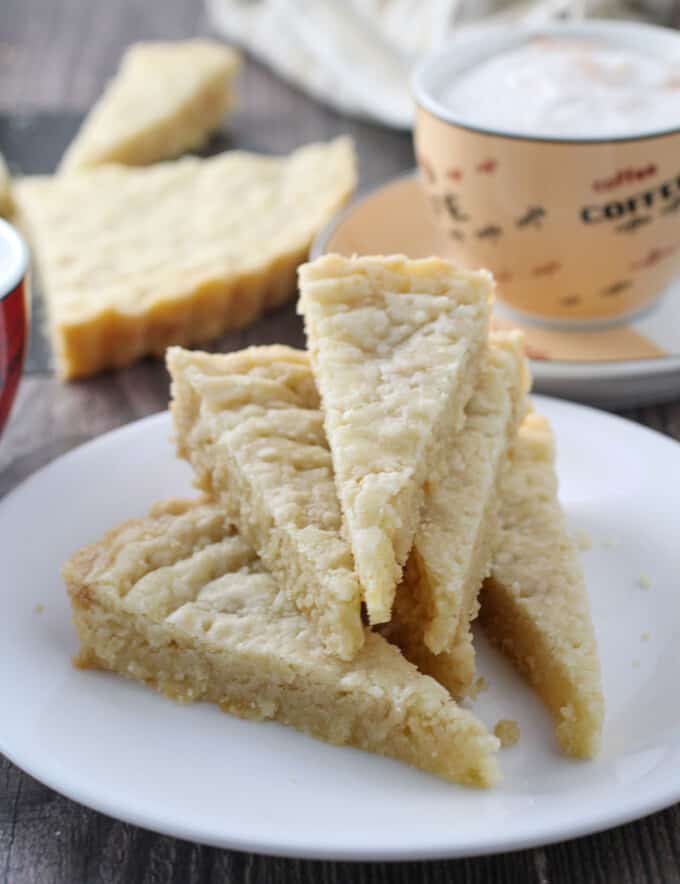

Ria says
Would it be bad if I re-steamed the sapin sapin after it was done cooking and cooled down for over a day? I noticed that there austin a lot of uncooked/really soft parts in the middle of the sapin sapin. Otherwise the taste is there and good, but the texture was like goo.
Mark says
This is a decent recipe.
I don't understand all the negative comments (e.g. Too soggy, too firm etc). I think the main issue with people having soggy or super soft sapin sapin is that they don't cover the lid with a cloth.
This is paramount to ensure the steam doesn't drip on your dessert.
Thanks Lalaine for your recipe!
Lalaine Manalo says
Thank you so much for the feedback, Mark!
Norman Tecson says
Hi Mark,
That's the beauty of the comment. The recipe must be close to perfection in terms of ingredients and procedure. If you miss 1 or 2 steps, it will not turn out good, if worse, uneatable.
I followed the recipe and sure its not a good one my sapin2x turns out raw and layers didnt blend it. I know my mistake and sad to say it doesnt specify in the procedure and even in the video.
God bless us all
Edgar sibulo says
I made this recipe , and everything is just
right ! I highly recommended this recipe!
Lalaine Manalo says
Thanks for the feedback! Glad it worked well for you 🙂
Norman Tecson says
Hi Edgar,
sure?? hehehe
Jenny says
Hi there ,what’s the Difference between coconut cream and coconut milk .i was thinking to make this recipe .i do have on hand the can coconut milk bought from the store .but not sure about coconut cream .can I still make it with out the coconut cream .
Juno Cruz says
I was having doubts about the ratios, I should have known better. I followed the recipe to the T and after 2 hours of steaming the 3 layers 1 at a time on a commercial steamer even, it's still so soggy even after it cooled down. Disappointing... Oh well, they do harden after a few days, maybe I will try to eat it then.
Lalaine Manalo says
I am sorry to hear the recipe didn't turn out well for you. I am not sure what consistency you're looking for but sapin-sapin is supposed to be soft and chewy and this is the texture you'll get from the recipe. Also, it does need to cool down completely to firm up a little and served at room temperature. 3 1/2 cups glutinous rice flour to 2 cans (13.5 ounces each) plus 1 can condensed milk makes a very thick batter and should set well when steamed. May I ask please if the ingredients were properly measured?
Michelle says
Hello, I've tried making this several times now and each time it comes out too soft/sticky. I've also covered the steamer lid with a towel to soak up excess moisture as other recipes call for. Any suggestions? I want to be able to slice and serve the pieces, but right now it has to be eaten with a spoon because it's so soft
Lalaine Manalo says
This is a soft and sticky cake. I am not sure what texture you're looking for. You can add more glutinous rice flour if you like they consistency firmer.
Carmela L. Dagoy says
Hi Ms Lalaine...Im confused as to how much water to add to freshly grated coconut to make coconut cream or milk...I'd prefer to use the fresh one than in can...pls help! Thanks a lot for sharing your recipe..
Lalaine Manalo says
I am sorry but I've pressed coconut milk before. I live in the US and we don't have access to freshly grated coconut 🙁
Gina says
Hi 🙂 what if i will use fresh coconut milk instead of canned?how many cups of coconut milk i will be use in this recipe.thanks in advance for your reply 🙂
Lovey says
Way too much glutinous rice flour. The mixture was so thick and stodgy and clumpy, I couldn't even stir it 🙁 I'm only leaving this feedback so people don't waste time and money like I did, I don't want to be mean but I need to keep looking for a recipe.
Lalaine Manalo says
Hello, Lovey,
I am so sorry to hear that the recipe didn't work well for you. The mixture shouldn't be too thick and hard to stir. It should be like a thick pancake batter. May I ask please if you used 4 cups glutinous rice flour and 2 cans of coconut milk (not coconut cream as that is very thick). 2 cans 13.5 ounces each for a total of 27 ounces/ 800 ml. If you search online for other sapin-sapin recipes, their proportions or ratio of flour and coconut milk is almost the same as this recipe.
Leen says
Is it 4 cups or 3 1/2 cups of glutinous rice flour? I just want to confirm cause on your recipe it’s 3 1/2 cups and on your comment reply it’s 4 cups.
Ellen says
Hi Ms Lane.. Thanks for the recipe.. I made this before. (April 2019) and I will be making it again tomorrow however I saw ur recipe changed from 3cups to 4cups glutinous rice flour. which one is correct? thanks
Remelyn S. Paguia says
Hi ma'am magkano po ba costing ng sapin-sapin? Ipang nenegosyo ko po kasi
Lalaine Manalo says
Hi Remelyn! I'm based in the US so I'm not sure what prices are in the Philippines. Sorry.
avril says
hi, i live in Canada. i'm not quite sure where you're from. but hopefully you have an idea where can i buy langka and ube extract in Canada?
Lalaine Manalo says
Hello there. I used to live in Southern California but now in Texas. Are there any Filipino or Asian stores near you?
Ryan says
How long will sapin2x last off the fridge?
Arsenia Ignacio says
I have Ube flour and i can’t find ube extract. Can I just pour 1/4 c of ube flour to the batter?
Lalaine Manalo says
The ube flour might change the consistency of the steamed sticky cake. And I believe you need to reconstitute the flour with water. Make it into a smooth paste following the package's directions and add 1/4 cup to the ube batter.
an says
hi.the mixture i made was so soggy i cant mix and it didnt dissolve properly.is there anything wrong
James says
Where do you get lanka and ube flavor extracts at? This is the first I've heard of this.
Lalaine Manalo says
I bought mine from an Asian supermarket in Southern California but you also order them on Amazon 🙂
Priscila Halog says
You can buy the ube and Langka extract from Amazon. The ube extract is $3.88 and the langka is $7.75
Imerald says
Mam, what could be used as substitute for rice flour? Here in our province we only have malagkit rice.is it okay if i have it ground with some water, then add sugar & coconut milk? Will I achieve a perfect sapin sapin, what is the measurement?
Lalaine says
Hello Imerald
The recipe calls for glutinous rice flour which is malagkit rice na giniling. Yes you can use malagkit rice but unfortunately, I haven't tried grinding it myself so I am not sure of the amounts to use 🙁